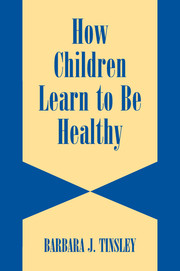Book contents
- Frontmatter
- Contents
- Acknowledgments
- How Children Learn to Be Healthy
- Introduction
- 1 Mechanisms and Consequences of Socializing Children to Be Healthy
- 2 Children's Health Understanding and Behavior
- 3 Parents' Health Beliefs
- 4 Parents' Promotion of Their Children's Health
- 5 Parents' Promotion of Their Children's Sexual Health
- 6 Peers, Schools, and Children's Health
- 7 How Television Viewing and Other Media Use Affect Children's Health
- 8 The Social Ecology of Children's Health Socialization
- 9 Summary and Conclusions
- References
- Index
1 - Mechanisms and Consequences of Socializing Children to Be Healthy
Published online by Cambridge University Press: 27 July 2009
- Frontmatter
- Contents
- Acknowledgments
- How Children Learn to Be Healthy
- Introduction
- 1 Mechanisms and Consequences of Socializing Children to Be Healthy
- 2 Children's Health Understanding and Behavior
- 3 Parents' Health Beliefs
- 4 Parents' Promotion of Their Children's Health
- 5 Parents' Promotion of Their Children's Sexual Health
- 6 Peers, Schools, and Children's Health
- 7 How Television Viewing and Other Media Use Affect Children's Health
- 8 The Social Ecology of Children's Health Socialization
- 9 Summary and Conclusions
- References
- Index
Summary
Heart disease and cancer are the first and second leading causes of death in the United States. Although great strides have been made in reducing deaths from heart disease in the past 20 years, due to improvements in treatment for hypertension and myocardial infarction and changes in diet, smoking levels, and exercise patterns, deaths from many cancers continue to increase. Cigarette smoking is the leading cause of lung cancer in both men and women. We know that 80% of smokers begin to smoke during adolescence and that attitudes learned in childhood and adolescence are the most powerful predictors of smoking in adulthood. Imagine how much additional reduction in the number of deaths caused by these two major killers could be achieved if children began to eat healthy diets in childhood, if they never started to smoke cigarettes, and if physical exercise was a natural part of every child's life.
There appears to be an inadequate U.S. national commitment to prevention and health promotion; our national investment in prevention is estimated at less than 5% of the total annual health cost (Stone et al., 2000), and without this orientation toward prevention, the prospects for children's health and functioning cannot be improved. Money is available to provide expensive hospital care for those with serious illnesses; thousands of preterm and otherwise sick infants are hospitalized for months at a time. But Americans make inadequate attempts to improve children's lives before they get sick, and many of today's children will reach adulthood unhealthy.
- Type
- Chapter
- Information
- How Children Learn to be Healthy , pp. 7 - 10Publisher: Cambridge University PressPrint publication year: 2002



